Pittsburgh, 1974
by Robert Dick
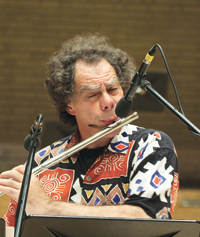 I first attended the Pittsburgh convention in 1974. It was NFAs third convention and my first presentation at any convention. I gave a lecture-demonstration on the relatively new field of extended techniques.
I first attended the Pittsburgh convention in 1974. It was NFAs third convention and my first presentation at any convention. I gave a lecture-demonstration on the relatively new field of extended techniques.
The early conventions were much smaller with perhaps 400-500 attendees in Pittsburgh and few events overlapped. Mostly one presentation or concert took place at a time. Most of the performers were the principal flutists from the major American orchestras. As a young musician not long out of graduate school, it was great to hear so many top players. There was much fine instrumental work, but strong, dramatic expression was in shorter supply. It also became very clear that one gets good at what one does. Flutists who sounded marvelous in the orchestra found that solo recitals did not always bring their best qualities to the fore. Endurance was a noticeable issue because solo playing does not provide the rests that orchestral playing does. That said, I also found myself transported by beautiful performances.
The music performed at the early conventions was pretty much drawn from the standard repertoire. It did not take very many years, though, for this to change, setting the stage for the incredible variety of repertoire performed at conventions today.
Being at one of the first conventions gave me the feeling of being in on the ground floor of something great. The energy, dedication and camaraderie of the flutists were infectious. Compared to the competitive environment I had experienced in school, music camps and masterclasses, it was an absolute revelation to see flutists cooperating, cheering for each other, and giving unstinting mutual support.
There was quite a bit of skepticism about new music and new sonorities and techniques back in the 1970s. Making my first presentation, I had no idea of what to expect. Would anyone show up? Would they laugh at me? Walk out? It is no understatement to say I was nervous from head to toe. I quickly learned something very important about flutists and musicians in general. If you have something to say, and say it in a respectful way, they will listen. After my presentation, there were many compliments on my playing and speaking. I had not attacked traditional music or playing, but rather had shown a new path for growth, and most of the hundred plus flutists at the presentation understood the message.
Having now attended over twenty-five NFA conventions as well as others around the world, I have seen how the flute world has grown wonderfully in all kinds of directions. Our musical lives are by far the richer for it. Authentic Baroque performance practice, world music, jazz, rock, new music, beatbox fluting, you name it; we have got it. Our performance standard some thirty-six years past the first Pittsburgh convention is incredibly higher today. Our embrace of flutists from around the world has been to the benefit of all.
In turn for all the great things the NFA has done for me, I have served the NFA in many capacities, as a Board of Directors member (twice), as the first chair of the New Music Advisory Committee, which chooses composers to commission, and as a member of several other committees. To those who might think “they’ll never want to pay attention to my views,” let me say the NFA is truly the “big tent” that other organizations claim to be. You are welcome and you belong.
Robert Dick is known internationally as a flute soloist, composer, author and inventor. He’s been recognized as a composer with a Guggenheim Fellowship and many grant’s and commissions, including three from the National Flute Association: “Lookout” for the High School Soloist competition, “everyone@universe.existence” for the Young Artists competition, and “Gravity’s Ghost” for the piccolo competition. Dick is the creator of the Glissando Headjoint®, the “whammy bar” for the flute. He teaches at NYU and the City University of New York Graduate Center as well as privately and over the internet. BA, Yale; MM Yale. Please visit www.robertdick.net and www.glissando.biz
Atlanta, 1976
by Katherine Borst Jones
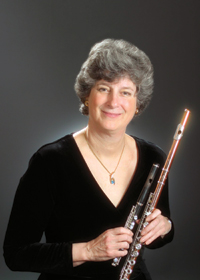 In 1976, I attended the NFA’s fourth convention in Atlanta, Georgia. I was a young teacher just getting started, teaching privately and with a few students at Capital University in Columbus, Ohio. I was also newly married. As I was waiting in line at hotel registration, old friends and teachers greeted me as Katherine Borst. However, proud of my new last name, I had pre-registered at the hotel as Katherine Jones. The hotel clerk and I quickly discovered there were several Katherine Jones at the hotel, so we added Borst to my registration card. To prevent confusion, from then on I was known as Katherine Borst Jones in the flute world.
In 1976, I attended the NFA’s fourth convention in Atlanta, Georgia. I was a young teacher just getting started, teaching privately and with a few students at Capital University in Columbus, Ohio. I was also newly married. As I was waiting in line at hotel registration, old friends and teachers greeted me as Katherine Borst. However, proud of my new last name, I had pre-registered at the hotel as Katherine Jones. The hotel clerk and I quickly discovered there were several Katherine Jones at the hotel, so we added Borst to my registration card. To prevent confusion, from then on I was known as Katherine Borst Jones in the flute world.
The early conventions were much smaller than they are today. I remember studying the program book trying to decide between attending one of two events and visiting the exhibits. As you make plans, be sure to include time for meals and lengthy visits to the exhibit hall.
That first convention provided the opportunity to speak to instrument makers and try multitudes of flutes (I grew up in the era where you ordered a flute from one of two companies, took what was sent, and played that flute for years.) I enjoyed meeting new people from different places. It takes courage to speak to a stranger in the elevator or someone seated next to you in a concert, but meeting colleagues and sharing ideas is one of the most important aspects of a convention.
On the last evening, we were packed into a room as Samuel Baron, the NFA president that year, presented a lifetime membership to Emil Medicus, the legendary flutist, arranger and author (The Flutist magazine). I was so inspired hearing Baron and Medicus speak. Later in the hallway, I saw Samuel Baron alone, summoned my courage, and said, “If ever there is anything I can do for the NFA, I hope you will let me know.” From that moment, I understood the importance of the organization and contemplated how I could become involved. Ten years later, I was nominated for Secretary/Treasurer and eventually served as President for two terms. The NFA always needs committed volunteers. If you are interested, speak to the Vice-Chair or any member of the Board of Directors. If I can be involved, so can you. It will change and enhance your life in many ways. I made lifetime friends with common goals and interests. It was worth every penny and minute spent.
Katherine Borst Jones is Professor of Flute at The Ohio State University, winner of both Distinguished Teacher Distinguished Scholar Awards, thefounder of the OSU High School Flute Workshop and the OSU Flute Troupe. She is a founding member and co-principal flutist of the ProMusica Chamber Orchestra, the trio, COSMOS, a member of the Columbus Symphony Orchestra and Principal flute of the New Sousa Band. She has served the NFA as President twice and was the 1992 Convention Program Chair.
Los Angeles, 1992
by Maria Ramey
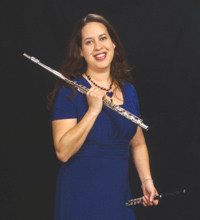 My very first flute convention was a musical whirlwind, a dream-like experience filled with amazing concerts, outdoor flute choir performances, giant flutes and glass elevators. I had just turned 12 years old, and my friend Debbie and I had recently acquired our first B-foot, open-hole flutes after a company brought an exhibit to our hometown. The company, impressed with our talent, invited us to perform in their dealer showcase at the convention.
My very first flute convention was a musical whirlwind, a dream-like experience filled with amazing concerts, outdoor flute choir performances, giant flutes and glass elevators. I had just turned 12 years old, and my friend Debbie and I had recently acquired our first B-foot, open-hole flutes after a company brought an exhibit to our hometown. The company, impressed with our talent, invited us to perform in their dealer showcase at the convention.
I was the oldest of four children being raised by a single mother. Funds were scarce. I had spent hundreds of hours selling candy and doing odd jobs to pay for my new flute and now a company was paying my convention costs. Debbie’s mom agreed to chaperone us. We stayed in a small hotel near the convention, and I used groceries from home to make sandwiches so I did not have to purchase food at the convention.
Each morning we woke up early, eager to get to the convention. There were so many concerts to see, flutes to play and new discoveries to make. One morning we attended part of the young artist competition rounds, and I was floored by the technical mastery and vibrant performances I heard there. It was both inspiring and a little daunting because I had only been playing for three years.
The convention hotel was a magical place to us with endless maze-like hallways, flute players everywhere you turned and a fascinating gift shop; but the best part was the glass elevators, located on the outside wall of the building. Debbie and I begged her mother every day to let us ride the 30 floors up and down, again and again, so we could marvel at the big-city scenery. The whole experience at the convention was one big adventure.
For the showcase I played Faure’s Sicilienne. I was so excited that I was not nervous at all. The room was small with a low ceiling but also elegant and filled with friendly flutists.
Two young men from Germany who had performed a duet on the showcase concert complimented me on my performance. Their words and kindness made a lasting impression on me. One asked whether we played duets together and gave us the duet book they had performed from, complete with their personal markings. I still have the music in my library.
After the showcase performance was over, we visited the exhibit hall. I will never forget the jaw-dropping moment when I saw a contrabass flute. I was thrilled when I was given reluctant permission to try it, but my excitement quickly turned to disappointment when I discovered I was not tall enough to play it. I also tried to play a Shakuhachi flute and could not produce a sound. I tried every flute and piccolo, stocked up on freebies, collected catalogs, and vowed to come back when I was tall enough to play that contrabass flute.
We were also invited to perform with the professional flute choir, where we felt both honored and overwhelmed as the youngest members of the group. We premiered some music by Katherine Hoover. She was the first woman composer I had met and I was quite impressed. The performance was outdoors under a canopy, with a light, cool breeze keeping the heat at bay and fluttering our music just enough to keep things exciting.
Maria Ramey is a professional flutist in the Los Angeles and Orange County areas. She is principal and solo alto with the Song of the Angels Flute Orchestra, Piccoloist for the Culver City, Marina Del Rey and Peninsula Symphonies and is also a board certified music therapist, working with adults with developmental disabilities and psychiatric illnesses.
Los Angeles, 1992
by Phyllis Avidan Louke
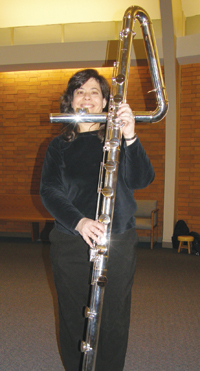 I attended my first NFA convention in 1992 in Los Angeles. I had resumed playing the flute two years earlier, after an eight-year absence that started with the birth of my first child. I wasn’t quite sure what to expect, but tagged along with two flute friends.
I attended my first NFA convention in 1992 in Los Angeles. I had resumed playing the flute two years earlier, after an eight-year absence that started with the birth of my first child. I wasn’t quite sure what to expect, but tagged along with two flute friends.
The Los Angeles convention was a much larger event than the Greater Portland Flute Society’s Flute Fair. The convention program listing all the events and bios was the size of a catalog. The exhibit hall filled the entire basement of the Bonaventure Hotel with tables and tables of flutes to try. There was also an incredible assortment of music and accessories for sale. As I walked through the exhibit hall, my flute bag got heavier and heavier as I added catalogs and bought more and more music. Having just started arranging and composing for flute choir in 1991, I was thrilled to see several of the exhibitors selling my music.
The many choices of activities each day made me feel like a kid in a candy store. There were morning warm-ups, concerts and workshops. Attending workshops plus five or more concerts a day made me long to play my flute. I wanted to be a participant instead of a spectator. My desire to play my flute was somewhat satisfied by attending a Flute Choir Reading Session, where I was surprised and delighted to find my arrangement of Hopak in the folder of pieces to be read. One of my roommates was performing with the Professional Flute Choir, so I attended her performance. I was so impressed that I decided to audition for the group the next year.
My desire to take a more active role at the NFA Convention has led me headlong into the wonderful world of flute choirs. I have now performed with the Professional Flute Choir (PFC) on bass or contrabass flute every year since 1993. Through this association, I have made many friends who share an interest in flute choirs, and have also received encouragement and inspiration for my composing. This association has opened many professional opportunities for me.
I would encourage you to attend the NFA convention this August. Start the convention early on Wednesday afternoon by participating in the Queen City Flute Orchestra and later in the Flute Choir Reading Sessions. Next year plan to audition for the professional flute choir. These activities give you the opportunity to make new friends and play with some incredible musicians.
Phyllis Avidan Louke is a private teacher, freelance flutist and composer in Portland, Oregon. She has co-authored several pedagogical publications with Patricia George: Flute 101: Mastering the Basics, Flute 102: Mastering the Basics, Flute 102: Solo Repertoire, and The Flute Scale Book: A Path to Artistry. www.phyllislouke.com
Columbus, 2000
by Sandy Saathoff
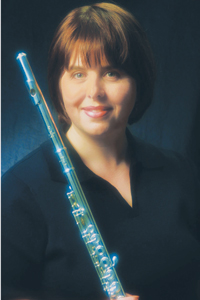 I remember the apprehension I felt when I sent in the registration for my first convention; I did not know anyone who was going, and it was a stretch financially for me to attend. The decision to attend was spurred by an invitation to meet with Liz Goodwin and become involved in a Flutewise project. Looking back, it was a blessing to have this contact pre-planned. Liz generously took me under her wing and introduced me to people. I could not have anticipated the scale or breadth of the program offerings, the treasures of the exhibit hall, or the value of the convention program book.
I remember the apprehension I felt when I sent in the registration for my first convention; I did not know anyone who was going, and it was a stretch financially for me to attend. The decision to attend was spurred by an invitation to meet with Liz Goodwin and become involved in a Flutewise project. Looking back, it was a blessing to have this contact pre-planned. Liz generously took me under her wing and introduced me to people. I could not have anticipated the scale or breadth of the program offerings, the treasures of the exhibit hall, or the value of the convention program book.
The convention itself was outstanding, with a steady parade of captivating performances and workshops. I was delighted to discover how easily flutists from various backgrounds talked with one another, and was quite surprised to see my own city of Sammamish, Washington on someone else’s nametag on the elevator.
It had been ten years since I was part of the flute world (due to a nerve disorder in my arm), and the convention offered an exceptional opportunity to dive back in. I returned home with enthusiasm and became more involved in the Seattle Flute Society, first as newsletter editor, then vice-president/program chair, and president. It was fun to incorporate my favorite experiences from NFA conventions into our local flute scene. I also discovered new repertoire gems to use with my private students and flute choirs.
Nothing prepared me, however, for a phone call I received in 2008. Leonard Garrison (then Vice-chair of the NFA Board of Directors) called to ask if I would run for the NFA Secretary. As Assistant Secretary in 2009 and Secretary in 2010, conventions became the work center for the Board of Directors. Meetings began before the convention and continued through the convention days. Evenings were spent preparing documents and minutes for the next day. This experience introduced me to a diverse, interesting group of people.
I will work with Program Chair Zart Dombourian-Eby in planning the 40th Anniversary convention in Las Vegas. If it will be your first time attending a convention, please come visit me during the “Orientation for First-Time Convention Attendees” which I will be leading on Wednesday, August 10 from 7-8 pm in the Convention Center.”
Sandra Saathoff teaches privately and is a clinician in the Seattle area. She performs with local orchestral, chamber and Scotch/Irish folk ensembles, and directs the flute program of the Bellevue Youth Symphony. She is an adjunct professor of flute at Seattle Pacific University, and has served on the executive boards for the National Flute Association, Seattle Flute Society and Flutewise USA.





